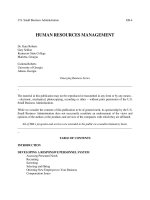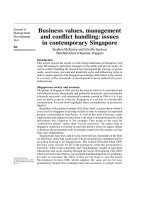Tài liệu E-Human Resource Management 24 ppt
Bạn đang xem bản rút gọn của tài liệu. Xem và tải ngay bản đầy đủ của tài liệu tại đây (882.93 KB, 9 trang )
E-Learning Strategies of Italian Companies 193
Copyright © 2005, Idea Group Inc. Copying or distributing in print or electronic forms without written
permission of Idea Group Inc. is prohibited.
aspects that can most easily be recognized by companies: cost savings and up-
rating a flexibly deployed workforce.
Recent research into e-HRM (Hansen & Deimler, 2001) developed a model
conceiving both sides of added value. If we apply the model developed by
Hansen and Deimler to the whole system of e-HRM applications, specifically
to e-learning, we may identify three facets of a B2E strategy for e-learning:
• Online business processes: The primary driver of this facet is to reduce
interaction and coordination costs and effort within the organization to do
the business with e-learning solutions (Maxey, 2003). A first objective is
the codification process of knowledge and information about product and
processes—for instance training in common processes in companies
interested by M&A strategies, or training on new products — in innovat-
ing companies. A second objective is enhancing individual information
exchanges by facilitating the creation of discussion groups and communi-
ties of practices as a by-product of an e-learning course. Third, e-learning
could help customer/employee interaction by providing just-in-time infor-
mation and integrating knowledge management tools with e-learning, such
as an information desk.
• Online people management: The primary driver of this facet is to
provide easy tools to help employees to develop personal skills and
competencies. This facet on one hand comprises bundles of policies like
online performance management and/or competency management comple-
mentary with e-learning. On the other hand a new direction of this policy
is to facilitate “learning in the context of work rather than in the context of
training” (Rosenberg, 2003) — increasing not only the freedom of
employees to choose the courses they think they need and the way they
learn through them, but also providing online access to something (knowl-
edge, information, material, etc.) that people need for a better perfor-
mance, when and where they want.
• Online services and processes: The primary driver of this facet is to
provide services and information useful for benefiting from e-learning
courses such as counseling, educational advice, or tutorship. E-learning
B2E applications may reduce costs and effort associated with delivery
and training courses, for instance by an online search for courses and
information on course availability.
194 Comacchio & Scapolan
Copyright © 2005, Idea Group Inc. Copying or distributing in print or electronic forms without written
permission of Idea Group Inc. is prohibited.
Emerging B2E Strategy for E-Learning in Italy
In the actual experience of Italian companies, some weak signals of an emerging
B2E strategy for e-learning can be seen (two in-depth case studies are in
Appendix Box 1 and Box 2):
• Online business processes: Respondents are interested in a company’s
benefits of streamlining learning processes. The importance of connectiv-
ity shows that online business processes of B2E e-learning strategy, thus
the coordination of employees spread throughout the organization and in
the field (sales force), is a primary driver. Another objective is the
codification process of knowledge and information of product and
processes, as the two cases of Unicredit and BPM illustrate. As previ-
ously mentioned, companies are in search of cheaper, faster solutions for
providing learning by information and by doing so in the context of work.
Figure 6. “B2E” perspective of e-learning
Services
&
Infrastr.
Contents
Users
E-LEARNING SOLUTION
Online
business processes
Online
people management
Online
services & processes
E-Learning Strategies of Italian Companies 195
Copyright © 2005, Idea Group Inc. Copying or distributing in print or electronic forms without written
permission of Idea Group Inc. is prohibited.
• Online people management: Italian companies analyzed seem to
implement e-learning with a push approach instead of a demand pull one.
Moreover, in the more advanced experiences, such as the cases of BPM
and Unicredit, e-learning is planned and delivered mainly by following
companies’ training programs and scheduling. Also, companies are not
investing in other policies related to e-learning, like knowledge manage-
ment and performance management. However, they pay a great deal of
attention to properly designed courses and tests, in order to overcome
individual problems and increase motivation. Companies interviewed
seem to be oriented to facilitate “learning in the context of work rather than
in the context of training” by providing just-in-time information.
• Online services and processes: Tutoring is, among other things, the
solution Italian companies favor most, even if companies approach it in
different ways: internal vs. external, push or pull tutorship, or both. As the
two cases (BPM and Unicredit) in the banking industry suggest, there is
no one best solution. This facet, as well as online people management,
aims to arouse the interest and the motivation of people, by providing
services and roles that make e-learning less “cold” and isolated.
Conclusions
This research was aimed at studying the adoption of e-learning in the Italian
pharmaceutical and banking industries and their e-learning strategy.
The ambiguity of decision gives importance to bandwagon pressures, and to
external networks of colleagues who HR professionals use when they need
information and suggestions about adopting e-learning. Results seem to confirm
that e-learning is more widespread and sophisticated in the banking industry,
where there are more bandwagon pressures. Some common traits can be
identified in the e-learning strategies of companies of the two industries.
However, the two cases studied, Unicredit and BPM, show that e-learning is
adopted by an implementation process that leads to firm-specific solutions.
By analyzing the main objectives and problems cited by companies inter-
viewed, the learners’ motivation is the current and future main issue of both
pharmaceutical and banking management. On one hand, e-learning, especially
based on self-directed training courses, allows more autonomous learning. This
196 Comacchio & Scapolan
Copyright © 2005, Idea Group Inc. Copying or distributing in print or electronic forms without written
permission of Idea Group Inc. is prohibited.
means that e-learning helps a participant choose how and when to access the
course. On the other hand, people face problems in terms of isolation,
complexity of multimedia tools, slowness in running cooperative tools, and
technological problems. Consequently, firms should care for their people
commitment by investing on the four features of their e-learning strategy.
Finally, with respect to our research methodology, it is worthwhile highlighting
that, given the explorative nature of the research, we have favored the analysis
of a small but significant group of companies, together with case studies, in
order to study in greater depth the dynamics of the adoption process at the
organizational level. A line of research could be the extension of the analysis to
other cases within the same industries, for stronger literal and theoretical
replication (Yin, 2003; Eisenhardt, 1989). The study of other industries,
characterized by different institutional and competitive pressures, could help to
test the bandwagon model.
References
Abrahamson, E., & Rosenkopf, L. (1993). Institutional and competitive
bandwagons: Using mathematical modeling as a tool to explore innovation
diffusion. Academy of Management Review, 18(3), 487-517.
Abrahamson, E., & Rosenkopf, L. (1997). Social network effects on the
extent of innovation diffusion: A computer simulation. Organization
Science, 8(3), 289-309.
Anee. (2002). E-learning 2001. Report of the Associazione dei Servizi e dei
contenuti multimediali, April.
Brewster, C., & Hegewisch, A. (Eds.). (1994). Policy and practices in
European human resource management. London: Routledge.
Cohen, W.M., & Levinthal, D.A. (1990). Absorptive capacity: A new per-
spective on learning and innovation. Administrative Science Quarterly,
35, 128-152.
Comacchio, A., & Camuffo, A. (1999). Diffusion patterns of lean practices:
Lessons from the European auto industry. In A. Comacchio, G. Volpato,
& A. Camuffo (Eds.), Automation in automotive industries. Berlin:
Springer
E-Learning Strategies of Italian Companies 197
Copyright © 2005, Idea Group Inc. Copying or distributing in print or electronic forms without written
permission of Idea Group Inc. is prohibited.
DiMaggio, P.J., & Powell, W.W. (1983). The iron cage revisited: Institutional
isomorphism and collective rationality in organizational fields. American
Sociological Review, 48, 147-160.
Eisenhardt, K. (1989). Building theories from case study research. Academy
of Management Review, 14(4), 532-550.
European Commission. (2003). Lifelong learning: An overview of national
measures in the EU Member States and Candidate Countries, European
trend chart on innovation, Brussel.
Granovetter, M. (1985). Economic action and social structure: The problem of
embeddedness. American Journal of Sociology, 91, 481-510.
Haberberg, A., & Binsardi, A. (2002). Institutional influences on organisational
consensus. Paper presented at the British Academy of Management
Conference, Hammersmith, London, UK. September.
Hansen, M.T., &Deimler, M.S. (2001). Cutting costs while improving morale
with B2E management. MIT Sloan Management Review, 43(1), 96-
100.
Horton, W. (2000). Designing Web-based training. New York: John Wiley
& Sons.
IDC. (2002). European corporate business skills training market forecast
and analysis 2000-2005.
Kirkpatrick, D.L. (1998). Evaluating training programs: The four levels
(2
nd
ed.). San Francisco: Berrett-Koehler.
Kruse, K. (1999). Real world WBT: Lessons learned at the Fortune 500.
Paper presented at the ASTD International Conference & Exposition,
Atlanta, Georgia.
Ley, T., & Ulbrich, A. (2002). Achieving benefits through integrating e-
learning and strategic knowledge management. Retrieved from
www.eurodl.org/materials/2002
Martin, G., Robson, I., & Jennings, A. (2002, September). When absorptive
capacity meets institutions and e-learning: Adopting, diffusing and exploit-
ing e-learning in organizations. Paper presented at the British Academy
of Management Annual Conference, Hammersmith, London, Septem-
ber.
Maxey, J. (2003) E-learning brain trust, ASTD, learning circuits. Retrieved
from www.learningcircuits.org/2003/sep2003/braintrust.htm









